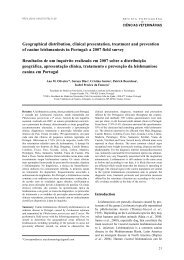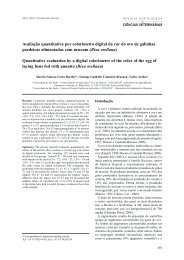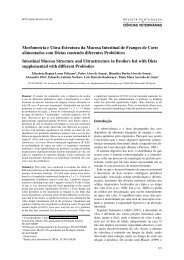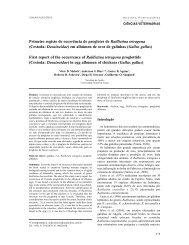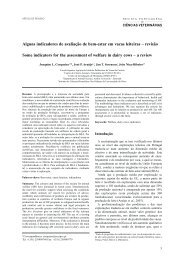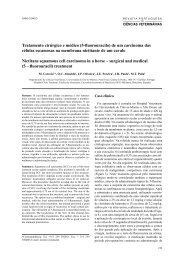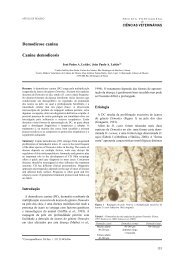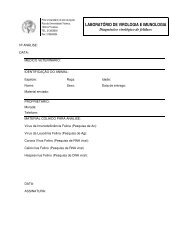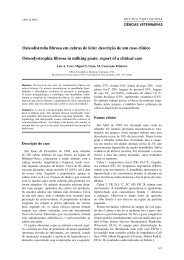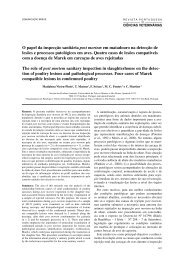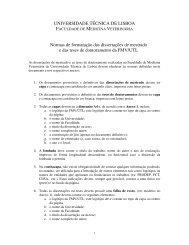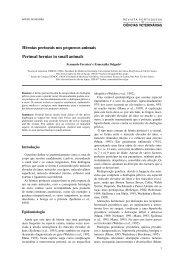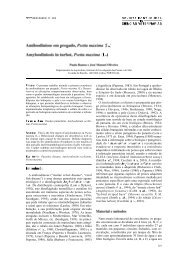Fish vaccination against infections by Streptococcal species and the ...
Fish vaccination against infections by Streptococcal species and the ...
Fish vaccination against infections by Streptococcal species and the ...
You also want an ePaper? Increase the reach of your titles
YUMPU automatically turns print PDFs into web optimized ePapers that Google loves.
Gomes S e Afonso A<br />
have been isolated in Japan <strong>and</strong> o<strong>the</strong>r countries in <strong>the</strong><br />
last years (Romalde <strong>and</strong> Toranzo, 1999). The production<br />
losses produced <strong>by</strong> <strong>the</strong> streptococcal septicaemias in<br />
cultured fish, <strong>the</strong> expense involved in using antimicrobial<br />
compounds, <strong>and</strong> <strong>the</strong> reported increasing drug resistance<br />
of <strong>the</strong> causative Gram-positive cocci (Aoki et al.,<br />
1990), point out <strong>the</strong> need for developing immunoprophylactic<br />
measures to prevent <strong>the</strong>se <strong>infections</strong> (Toranzo<br />
et al., 1995). Several attempts have been made to develop<br />
appropriate <strong>vaccination</strong> programs for fish streptococcosis<br />
(Iida et al., 1981; Carson <strong>and</strong> Munday, 1990; Ghittino et<br />
al., 1995; Akhlaghi et al., 1996; Romalde et al., 1996;<br />
Bercovier et al., 1997; Eldar et al., 1997; Romalde et al.,<br />
1999a). The use of bacterins with L. garvieae or S. iniae<br />
formalin-inactivated cells rendered good levels of protection<br />
in rainbow trout when administered intraperitoneally<br />
(Bercovier et al., 1997; Eldar et al., 1997),<br />
although differences regarding <strong>the</strong> duration of protection<br />
were observed for each <strong>species</strong>. Passive immunization of<br />
rainbow trout <strong>against</strong> Streptococcus sp. employing antibodies<br />
raised in sheep, rabbit or fish, was also evaluated<br />
(Akhlaghi et al., 1996). The results obtained were comparable<br />
to those of active immunization in both protective<br />
effect <strong>and</strong> duration (Romalde <strong>and</strong> Toranzo, 2002).<br />
These observations indicate that passive immunization<br />
may be important in <strong>the</strong> prevention of fish streptococcosis.<br />
Recently, it has been documented that β-glucans<br />
(schizophyllan <strong>and</strong> scleroglucan) have a protective effect<br />
<strong>against</strong> Streptococcus sp. infection when administered<br />
<strong>by</strong> intraperitoneal injection (Matsuyama et al., 1992).<br />
Protection of rainbow trout after intraperitoneal <strong>vaccination</strong><br />
with a formalin-killed S. iniae vaccine was reported<br />
<strong>by</strong> Eldar et al. (1997). Klesius et al. (1999, 2000) have<br />
developed a modified-killed S. iniae vaccine composed<br />
of whole cells <strong>and</strong> concentrated, extracellular products.<br />
Turbot were protected <strong>against</strong> Enterococcus sp. after<br />
<strong>vaccination</strong> with a toxoid-enriched bacterin (Toranzo et<br />
al., 1995; Romalde et al., 1996; Romalde et al., 1999a).<br />
Rainbow trout immunized with formalin-killed Streptococcus<br />
sp. in Freund’s Incomplete Adjuvant were protected<br />
<strong>against</strong> homologous Streptococcus sp. whereas<br />
trout immunized <strong>by</strong> bath immersion were not protected<br />
(Akhlaghi et al., 1996). Recently, Nakanishi et al. (2002)<br />
demonstrated that <strong>the</strong> protection induced in skin-punctured<br />
juvenile rainbow trout immersed in a formalinkilled<br />
S. iniae vaccine suspension rivalled that obtained<br />
<strong>by</strong> intraperitoneal injection (Evans et al., 2004).<br />
Lactococcosis – a particular case of streptococcosis<br />
The first description of L. garvieae (formerly E.<br />
seriolicida) came from an investigation of bovine<br />
mastitis in Great Britain (Collins et al., 1984). Later,<br />
L. garvieae was isolated from a variety of diseased<br />
freshwater <strong>and</strong> marine fish, <strong>and</strong> also from humans<br />
(Elliot et al., 1991), indicating <strong>the</strong> increasing importance<br />
of this bacterium, as a pathogen of fish <strong>and</strong><br />
potential zoonotic agent (Romalde <strong>and</strong> Toranzo, 2002).<br />
30<br />
RPCV (2006) 101 (557-558) 25-35<br />
The identification criteria for L. garvieae based on<br />
biochemical <strong>and</strong> antigenic characteristics is very similar<br />
to L. lactis subsp. lactis, which has also been reported<br />
as a human pathogen (Collins et al., 1984; Mannion<br />
<strong>and</strong> Rothburn, 1990; Elliot et al., 1991; Doméneche et<br />
al., 1993) <strong>and</strong> from Enterococcus-like strains isolated<br />
from diseased fish (Toranzo et al., 1994; Nieto et al.,<br />
1995). Gram-positive cocci which are capable of<br />
growth between 10 <strong>and</strong> 42 ºC, at pH 9.6, in <strong>the</strong> presence<br />
of 6.5% NaCl <strong>and</strong> on 0.3 % methylene blue-milk agar<br />
can be identified as L. garvieae. The recent work of<br />
Eldar et al. (1999) <strong>and</strong> Vela et al. (1999) reveals <strong>the</strong><br />
phenotypic heterogeneity of L. garvieae. Both workers<br />
proposed biotyping schemes which recognized three<br />
biotypes of L. garvieae. While based on <strong>the</strong> same phenotypic<br />
traits (acidification of tagatose, ribose <strong>and</strong><br />
sucrose), <strong>the</strong>re are some inconsistencies between <strong>the</strong><br />
typing schemes described <strong>by</strong> <strong>the</strong> above authors. A possible<br />
explanation for this is <strong>the</strong> use of <strong>the</strong> Api-20Strep<br />
<strong>and</strong>/or Api-32Strep miniaturized systems for biochemical<br />
characterization of <strong>the</strong> strains. Ravelo et al.<br />
(2001) demonstrated that <strong>the</strong>se systems may yield different<br />
results depending on <strong>the</strong> medium used for<br />
obtaining <strong>the</strong> bacterial inocula. In addition, <strong>the</strong> results<br />
achieved for some tests (i.e. acid production from: lactose,<br />
maltose, sucrose, tagatose <strong>and</strong> cyclodextrin) did<br />
not always correlate with results obtained with traditional<br />
plate <strong>and</strong> tube procedures. Moreover, although<br />
<strong>the</strong> strains studied <strong>by</strong> <strong>the</strong>se authors showed variability<br />
for some characters, no biotypes with epidemiological<br />
value could be established. More recently, Vela et al.<br />
(2000) proposed a new intra<strong>species</strong> classification of<br />
L. garvieae with 13 biotypes, on <strong>the</strong> basis of acidification<br />
of sucrose, tagatose, mannitol <strong>and</strong> cyclodextrin<br />
<strong>and</strong> <strong>the</strong> presence of <strong>the</strong> enzymes pyroglutamic acid<br />
arylamidase <strong>and</strong> N-acetyl-ß-glucosaminidase, although<br />
only 6 of <strong>the</strong>se biotypes were isolated from fish. In<br />
1991, Kusuda et al. (1991) proposed a new <strong>species</strong><br />
E. seriolicida, in order to bring toge<strong>the</strong>r a number of<br />
Gram-positive isolates recovered from Japanese<br />
yellowtail over <strong>the</strong> preceding 20 years (Kusuda et al.,<br />
1976; Kusuda et al., 1991). Subsequent phenotypic <strong>and</strong><br />
molecular characterization of E. seriolicida demonstrated<br />
that this <strong>species</strong> should be reclassified as a junior synonym<br />
of L. garvieae (Doméneche et al., 1993; Eldar et<br />
al., 1996; Pot et al., 1996; Teixeira et al., 1996). An interesting<br />
feature of <strong>the</strong>se Japanese isolates was <strong>the</strong> existence<br />
of two serotypes, which could not be distinguished<br />
from one ano<strong>the</strong>r biochemically. These two serotypes<br />
were associated with <strong>the</strong> presence (serotype KG-) or<br />
absence (serotype KG+) of a capsule. This capsule was<br />
reported to confer various properties on isolates, including<br />
a hydrophilic character, resistance to phagocytosis,<br />
<strong>and</strong> higher pathogenicity (Kitao, 1982; Yoshida et al.,<br />
1996; Yoshida et al., 1997). Freshly isolated cultures of<br />
this bacterium consist almost entirely of <strong>the</strong> KGserotype.<br />
Barnes <strong>and</strong> Ellis (2004) observed that antisera<br />
rose <strong>against</strong> capsulated isolates regardless of <strong>the</strong>ir origin



